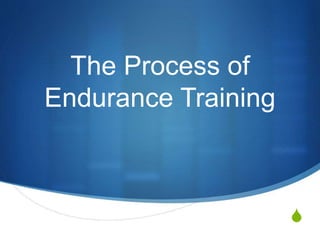
The Process of Training
- 1. S The Process of Endurance Training
- 2. S “What we see of the real world is not the unvarnished real world but a model of the real world, regulated and adjusted by sense data- a model that is constructed so that it is useful for dealing with the real world” Richard Dawkins
- 3. S “Oversimplifications…cut through the hideous complexity with a working model that is almost right, postponing the messy details until later” Dan Dennett
- 4. What is Endurance? S “cardiovascular endurance, aerobic fitness, or stamina, is the ability to exercise continuously for extended periods without tiring.” S “ability to exert itself and remain active for a long period of time, as well as its ability to resist fatigue.” S “Muscular endurance is the ability of a muscle or group of muscles to sustain repeated contractions against a resistance for an extended period of time.”
- 6. Extension S Metabolic- Aerobic quicker/longer? S Biomechanical- maintain stride rate/length S Neural- maintain muscle recruitment/force into ground
- 7. Data from: Scribe motion
- 10. Sprinting is Endurance!?! S Ground contact times lengthen S Force into ground drops S Stride length/rate change.
- 11. Fatigue Models S Neural S Psychobiological S Cognitive S Biomechanical
- 14. Simple Integrated Model of Fatigue 1. Products of fatigue build up 2. The brain monitors this increase in fatigue products 3. If things look bleak, Brain regulates how hard we can work via changing muscle recruitment 4. We get tired, slow down, become less efficient.
- 15. S Can train to: S Delay buildup of these products thus delaying brain’s signal to shut down S Delay signal from brain to “shut down and protect” by proving you can safely handle slightly more of that product. S Increase maximum amount of these products that can be accumulated or lost before the brain starts shutting things down. S Increase psychological drive/how much we care.
- 17. Endurance? How? What a COACH needs to figure out: S The training adaptation we are looking for. S What stimulus leads to that adaptation? S How much is enough?
- 18. Knowing the Adaptation S Traditional Model S Athlete Centered Model
- 19. S BUILD the race you want to. S Create the PATTERN you want.
- 20. S Event Demands S Not ONLY metabolic/energy system S How it’s used more important S Psychological/Cognitive S What decisions have to be made? S What/when are the psychological stressors S Neural/Biomechanical
- 22. Chunking S Group info into smaller number of parts based on patterns. S Relevant vs. Irrelevant
- 23. What are you working with? 800m- 1:49.90 1:48.40 1:49.1 1:49.081:49.33
- 24. What are you working with? 800m- 1:49.90 1:48.40 1:49.1 1:49.081:49.33 400m- 48.2 49+ 49.5+ 47.8+ 48.1 XC-didn’t make conf. 4th in conf. 3:56.45mile 9th XC conf. 25th conf. Mechanics: Power stride “sits” finesse/long varies power
- 25. Where does the athlete fall on the spectrum? Slow Twitch FastTwitch
- 26. S How to tell? S Lactate testing S Max lactate (after 400-600m) S 18+= very FT (expect mid distance or shorter) S Strengths vs. Weaknesses S FT- sprints, short intervals S ST- Long Runs, tempos S PR comparison S Power testing S Standing broad jump S 25m one legged jumps for distance S Stride mechanics S Elastic and reactive VS. flat and “grinder” Individualization
- 27. S Indoors- “traditional” 800/1500m training S Results: S Sucked S (4:07mi) S Outdoors- 5k/3k runner with “spices” of speed S Results: S 1:48.40 800m (school record)
- 29. S What Direction? S How hard? S How often? S How much? S Stimulus S Recovery S Adaptation
- 30. S How much, hard, often? S 50mpw or 100mpw? S 2,3,4 interval workouts per week? S 10x400s at 65 or 15x400s at 65?
- 31. How to decide? Don’t go somewhere until you need to go somewhere. S Do you NEED 100mpw now to improve to a necessary degree? S How hard? S “Being "in the zone" for maximum adaptability occurs when your perception of your ability to cope with a challenge is greater by some optimum amount than your perception of the difficulty of the challenge.” (Gershon Tenenbaum)
- 32. Where do they come from? S CLEAN SLATE S ANYTHING is a stimulus S 10+ years of training S What direction do you need to go? S How can you provide new stimulus VS.
- 33. S Basically… S How adapted are you in the direction you are trying to improve?
- 34. How challenging?
- 35. S Tools
- 37. Tools S 10x400 in 60 with 60sec recovery… S faster? S Rest? S Rep length longer? S Volume? S Density? S Add extra work (strength, exercises, etc) S Environment? (Hills, sand, heat, boredom) S WAY it is run (surges, tactics) S Feedback!
- 38. Tools S It isn’t High Intensity VS. Low Intensity S You have EVERY intensity at your disposal. S Use them. S Sprinting to slow running!
- 40. BE CREATIVE S Endurance is a spectrum. It all connects.
- 41. Goal of Workout S Stimulus to Adapt in the DIRECTION you want S WIN the workout S Manipulate it to win! S Pattern good movements.
- 42. Look Around S Above and Below!
- 43. S Sometimes to do this…. S 4xmile at 4:22 with 3min rest S Need to do more of this.. S 20min @ 5:00 pace, 3min jog, 1mi @ 4:45 S OR S This… S 6x400 @ 60 with 1min rest
- 44. SO what? S Did I talk about S VO2max? S Mitochondrial density? S Capillarization? S Lactate threshold? S Running Economy? S THOSE are CONSEQUENCES of good training, not goals.
- 45. S We don’t aim to improve a parameter, we aim to improve the varieties of endurance… S In the direction that we want to
